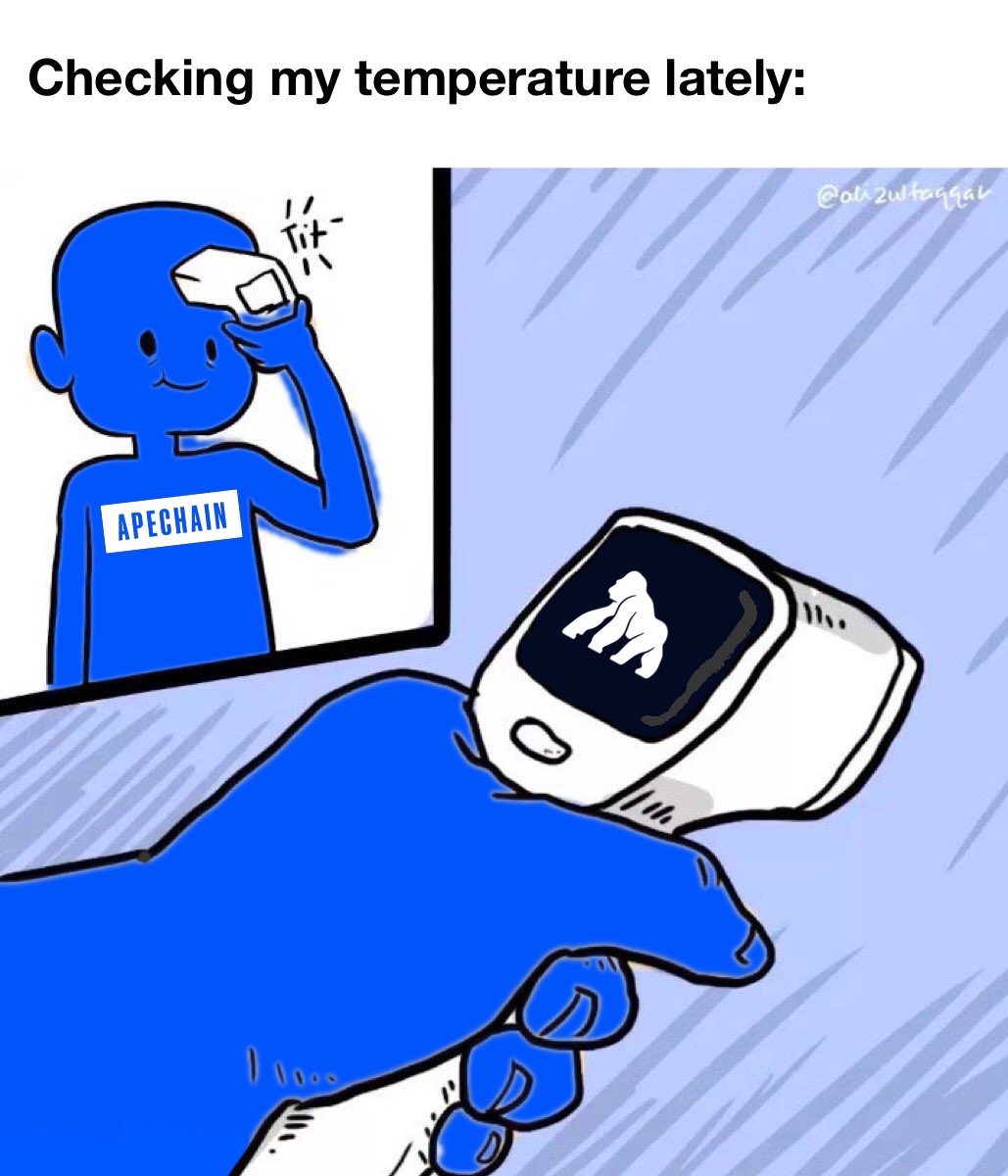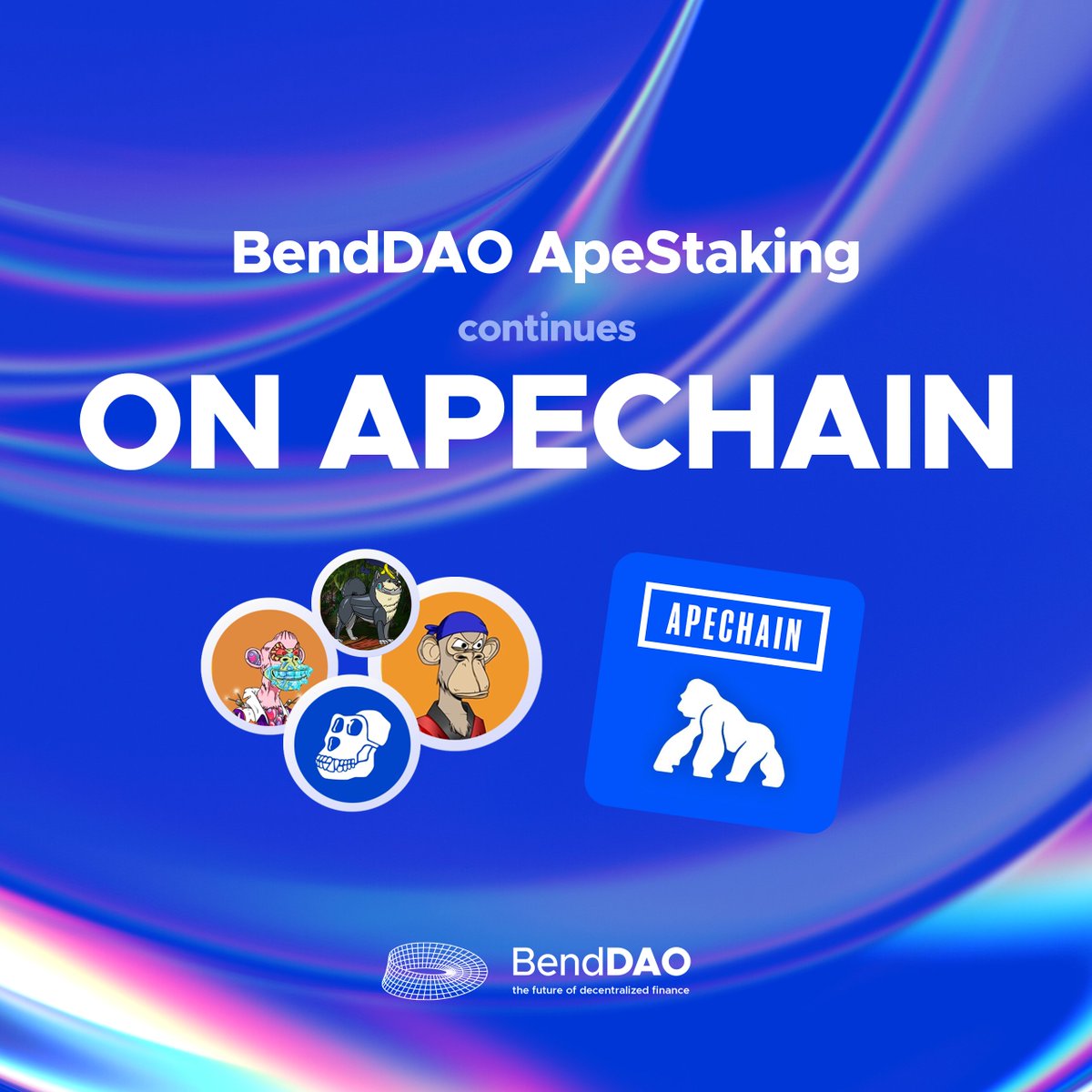
APE
ApeCoin-pris
$0,62900
-$0,04100
(−6,12 %)
Prisförändring de senaste 24 timmarna

Hur känner du för APE idag?
Dela dina känslor här genom att göra tummen upp om du känner dig bullish för coin eller tummen ner om du känner dig bearish.
Rösta för att visa resultat
Friskrivningsklausul
Det sociala innehållet på den här sidan ("Innehållet"), inklusive men inte begränsat till tweets och statistik som tillhandahålls av LunarCrush, kommer från tredje part och tillhandahålls " i befintligt skick" och endast i informationssyfte. OKX garanterar inte innehållets kvalitet eller sanningshalt, och innehållet representerar inte OKX:s åsikter. Det är inte avsett att tillhandahålla (i) investeringsrådgivning eller -rekommendationer; (ii) ett erbjudande eller en uppmaning att köpa, sälja eller inneha digitala tillgångar; eller (iii) finansiell, redovisnings-, juridisk eller skatterådgivning. Digitala tillgångar, inklusive stabil kryptovaluta och NFT:er, innebär en hög grad av risk och kan fluktuera kraftigt. Priset och prestandan för den digitala tillgången är inte garanterade och kan ändras utan föregående meddelande.<br>OKX tillhandahåller inga rekommendationer om investeringar eller tillgångar. Du bör noga överväga om handel eller innehav av digitala tillgångar är lämpligt för dig, med tanke på din ekonomiska situation. Vänligen rådfråga en juridisk-/skatte-/investeringsrådgivare för frågor om just dina specifika omständigheter. För mer information, vänligen se våra <a href="/help/terms-of-service">Användarvillkor</a> och <a href="/help/risk-compliance-disclosure">Riskvarning</a>. Genom att använda tredjepartswebbplatsen (”third-party website/TPW”) godkänner du att all användning av TPW kommer att omfattas av och regleras av villkoren i TPW. Om inte annat uttryckligen anges skriftligen är OKX och dess dotterbolag ( OKX ) inte på något sätt associerade med ägaren eller operatören av TPW. Du samtycker till att OKX inte är ansvarigt eller skyldigt för någon förlust, skada eller andra konsekvenser som uppstår på grund av din användning av TPW. Vänligen observera om att användning av en TPW kan resultera i förlust eller minskning av dina tillgångar. Produkten kanske inte är tillgänglig i alla jurisdiktioner.
ApeCoin marknadsinfo
Marknadsvärde
Marknadsvärde beräknas genom att multiplicera det cirkulerande utbudet av ett coin med dess senaste pris.
Börsvärde = Cirkulerande utbud × Senaste pris
Börsvärde = Cirkulerande utbud × Senaste pris
Cirkulerande utbud
Totalt belopp för ett coin som är allmänt tillgängligt på marknaden.
Marknadsvärde-rankning
Ett coins rankning i termer av marknadsvärde.
Högsta någonsin
Högsta pris ett coin har nått i sin handelshistorik.
Lägsta någonsin
Lägsta pris ett coin har nått i sin handelshistorik.
Marknadsvärde
$502,22M
Cirkulerande utbud
799 455 492 APE
79,94 % av
1 000 000 000 APE
Marknadsvärde-rankning
--
Granskningar

Senaste granskningen: 24 mars 2022
Högsta priset under 24 tim
$0,67500
Lägsta priset under 24 tim
$0,62300
Högsta någonsin
$28,0000
−97,76 % (-$27,3710)
Senast uppdaterad: 17 mars 2022
Lägsta någonsin
$0,34870
+80,38 % (+$0,28030)
Senast uppdaterad: 7 apr. 2025
ApeCoin-flödet
Följande innehåll är hämtat från .

Buuvei
Ett liv i överflöd (PÅ APECHAIN).
fler NFT:er. (PÅ APECHAIN)
mer tro. (PÅ APECHAIN)
Mer innehåll. (PÅ APECHAIN)
fler internetvänner. (PÅ APECHAIN)
mer pasta. (PÅ APECHAIN)
fler vinster. (PÅ APECHAIN)
mer hjärnröta. (PÅ APECHAIN)
fler memes. (PÅ APECHAIN)
fler utkast. (PÅ APECHAIN)
fler bullposts. (PÅ APECHAIN)
mer torrt pulver. (PÅ APECHAIN)
mer $APE. (PÅ APECHAIN)
Högre.


TheHodlrCollective
Ett liv i överflöd (PÅ APECHAIN).
fler NFT:er. (PÅ APECHAIN)
mer tro. (PÅ APECHAIN)
Mer innehåll. (PÅ APECHAIN)
fler internetvänner. (PÅ APECHAIN)
mer pasta. (PÅ APECHAIN)
fler vinster. (PÅ APECHAIN)
mer hjärnröta. (PÅ APECHAIN)
fler memes. (PÅ APECHAIN)
fler utkast. (PÅ APECHAIN)
fler bullposts. (PÅ APECHAIN)
mer torrt pulver. (PÅ APECHAIN)
mer $APE. (PÅ APECHAIN)
Högre.

6,6 tn
9

🐝 (🌐/acc)
Min Aptos, Uttråkade Apa. Borta.


Coinbase 🛡️
Cyberbrottslingar mutade och rekryterade oseriösa utländska supportagenter för att hämta personuppgifter på <1 % av Coinbase MTU:er. Inga lösenord, privata nycklar eller pengar exponerades. Prime-konton är orörda. Vi kommer att ersätta drabbade kunder. Mer här:
1,63 tn
11

ChainCatcher 链捕手
ChainCatcher News, NFT-handelsplattformen APE NFT meddelade idag att den har nått ett strategiskt samarbete med Emerald AIGame, och NFT:n med jade-tema kommer officiellt att landa på APE NFT-plattformen.
APE NFT fortsätter att utöka NFT-applikationsscenarier, och detta samarbete gör det möjligt för samlare att uppleva det roliga med jadebrytning i metaversen, och plattformsanvändare kan få token-airdrops, fysiska jadebelöningar och insatsbelöningar genom att inneha NFT:er. APE NFT kommer att ge ett allsidigt stöd för projektet och ytterligare främja värdekopplingen mellan NFT och fysiska konstverk.
Visa original1,28 tn
0
APE-kalkylator


ApeCoin prisutveckling i USD
Aktuellt pris på ApeCoin är $0,62900. Under de senaste 24 timmarna har ApeCoin minskade med −6,12 %. Det har för närvarande ett cirkulerande utbud av 799 455 492 APE och ett maximalt utbud av 1 000 000 000 APE, vilket ger ett marknadsvärde efter full utspädning på $502,22M. För tillfället innehar ApeCoin-coin position 0 i marknadsvärdesrankningar. ApeCoin/USD-priset uppdateras i realtid.
Idag
-$0,04100
−6,12 %
7 dagar
+$0,10390
+19,78 %
30 dagar
+$0,21110
+50,51 %
3 månader
-$0,11980
−16,00 %
Populära ApeCoin-omvandlingar
Senast uppdaterad: 2025-05-15 21:59
| 1 APE till USD | 0,62820 $ |
| 1 APE till EUR | 0,56088 € |
| 1 APE till PHP | 35,0284 ₱ |
| 1 APE till IDR | 10 381,76 Rp |
| 1 APE till GBP | 0,47266 £ |
| 1 APE till CAD | 0,87862 $ |
| 1 APE till AED | 2,3074 AED |
| 1 APE till VND | 16 291,49 ₫ |
Om ApeCoin (APE)
Betyget som anges är ett sammanställt betyg som inhämtats av OKX från källorna som anges, och det anges endast för informativa syften. OKX garanterar inte betygens kvalitet eller korrekthet. Det är inte avsett att utgöra (i) investeringsrådgivning eller rekommendation, (ii) ett erbjudande eller en uppmaning att köpa, sälja eller inneha digitala tillgångar, eller (iii) finansiell, redovisningsmässig, juridisk eller skattemässig rådgivning. Digitala tillgångar, inklusive stabil kryptovaluta och NFT:er, omfattas av hög risk, kan skifta kraftigt och till och med bli värdelösa. Priset och prestanda för de digitala tillgångarna garanteras inte, och de kan förändras utan föregående meddelande. Dina digitala tillgångar täcks inte av försäkran mot potentiella förluster. Historisk avkastning är ingen garanti om framtida avkastning. OKX garanterar inte någon avkastning, återbetalning av huvudbelopp eller ränta. OKX tillhandahåller inga rekommendationer om investeringar eller tillgångar. Du bör noga överväga om handel med eller innehav av digitala tillgångar är lämpligt för dig med hänsyn till din ekonomiska situation. Rådgör med din jurist, skatteexpert eller investeringsrådgivare om du har frågor om dina specifika omständigheter.
Visa mer
- Officiell webbplats
- Block explorer
Om tredjeparts webbplatser
Om tredjeparts webbplatser
Genom att använda tredjepartswebbplatsen (”TPW”) samtycker du till att all användning av TPW kommer att omfattas av och styras av villkoren i TPW. Om inte annat uttryckligen anges skriftligen är OKX och dess affiliates (”OKX”) inte på något sätt associerade med ägaren eller operatören av TPW. Du samtycker till att OKX inte är ansvarigt eller skadeståndsskyldigt för förlust, skada eller andra konsekvenser som uppstår till följd av din användning av TPW. Var medveten om att användning av en TPW kan leda till förlust eller minskning av dina tillgångar.
Vanliga frågor för ApeCoin
Hur mycket är 1 ApeCoin värd idag?
För närvarande är en ApeCoin värd $0,62900. För svar och insikt om prisåtgärder för ApeCoin är du på rätt plats. Utforska de senaste diagrammen för ApeCoin och handla ansvarsfullt med OKX.
Vad är kryptovalutor?
Kryptovalutor, till exempel ApeCoin, är digitala tillgångar som fungerar på en offentlig reskontra som kallas blockkedjor. Läs mer om coins och tokens som erbjuds på OKX och deras olika attribut, som inkluderar live-priser och realtidsdiagram.
När uppfanns kryptovalutor?
Tack vare finanskrisen 2008 ökade intresset för decentraliserad finansiering. Bitcoin erbjöd en ny lösning genom att vara en säker digital tillgång på ett decentraliserat nätverk. Sedan dess har många andra tokens som t.ex. ApeCoin skapats också.
Kommer priset på ApeCoin gå upp idag?
Se vår ApeCoin prisprognossida för att förutse framtida priser och fastställa dina prismål.
ESG-upplysning
ESG-regleringar (Environmental, Social och Governance) för kryptotillgångar syftar till att ta itu med eventuell miljöpåverkan (t.ex. energiintensiv mining), främja transparens och säkerställa etiska förvaltningsmetoder för att anpassa kryptoindustrin till bredare hållbarhets- och samhälleliga mål. Dessa regleringar uppmuntrar efterlevnad av standarder som minskar risker och främjar förtroende för digitala tillgångar.
Tillgångsdetaljer
Namn
OKcoin Europe LTD
Relevant juridisk enhetsidentifierare
54930069NLWEIGLHXU42
Namn på kryptotillgången
ApeCoin
Konsensusmekanism
ApeCoin is present on the following networks: ethereum, polygon.
The Ethereum network uses a Proof-of-Stake Consensus Mechanism to validate new transactions on the blockchain. Core Components 1. Validators: Validators are responsible for proposing and validating new blocks. To become a validator, a user must deposit (stake) 32 ETH into a smart contract. This stake acts as collateral and can be slashed if the validator behaves dishonestly. 2. Beacon Chain: The Beacon Chain is the backbone of Ethereum 2.0. It coordinates the network of validators and manages the consensus protocol. It is responsible for creating new blocks, organizing validators into committees, and implementing the finality of blocks. Consensus Process 1. Block Proposal: Validators are chosen randomly to propose new blocks. This selection is based on a weighted random function (WRF), where the weight is determined by the amount of ETH staked. 2. Attestation: Validators not proposing a block participate in attestation. They attest to the validity of the proposed block by voting for it. Attestations are then aggregated to form a single proof of the block’s validity. 3. Committees: Validators are organized into committees to streamline the validation process. Each committee is responsible for validating blocks within a specific shard or the Beacon Chain itself. This ensures decentralization and security, as a smaller group of validators can quickly reach consensus. 4. Finality: Ethereum 2.0 uses a mechanism called Casper FFG (Friendly Finality Gadget) to achieve finality. Finality means that a block and its transactions are considered irreversible and confirmed. Validators vote on the finality of blocks, and once a supermajority is reached, the block is finalized. 5. Incentives and Penalties: Validators earn rewards for participating in the network, including proposing blocks and attesting to their validity. Conversely, validators can be penalized (slashed) for malicious behavior, such as double-signing or being offline for extended periods. This ensures honest participation and network security.
Polygon, formerly known as Matic Network, is a Layer 2 scaling solution for Ethereum that employs a hybrid consensus mechanism. Here’s a detailed explanation of how Polygon achieves consensus: Core Concepts 1. Proof of Stake (PoS): Validator Selection: Validators on the Polygon network are selected based on the number of MATIC tokens they have staked. The more tokens staked, the higher the chance of being selected to validate transactions and produce new blocks. Delegation: Token holders who do not wish to run a validator node can delegate their MATIC tokens to validators. Delegators share in the rewards earned by validators. 2. Plasma Chains: Off-Chain Scaling: Plasma is a framework for creating child chains that operate alongside the main Ethereum chain. These child chains can process transactions off-chain and submit only the final state to the Ethereum main chain, significantly increasing throughput and reducing congestion. Fraud Proofs: Plasma uses a fraud-proof mechanism to ensure the security of off-chain transactions. If a fraudulent transaction is detected, it can be challenged and reverted. Consensus Process 3. Transaction Validation: Transactions are first validated by validators who have staked MATIC tokens. These validators confirm the validity of transactions and include them in blocks. 4. Block Production: Proposing and Voting: Validators propose new blocks based on their staked tokens and participate in a voting process to reach consensus on the next block. The block with the majority of votes is added to the blockchain. Checkpointing: Polygon uses periodic checkpointing, where snapshots of the Polygon sidechain are submitted to the Ethereum main chain. This process ensures the security and finality of transactions on the Polygon network. 5. Plasma Framework: Child Chains: Transactions can be processed on child chains created using the Plasma framework. These transactions are validated off-chain and only the final state is submitted to the Ethereum main chain. Fraud Proofs: If a fraudulent transaction occurs, it can be challenged within a certain period using fraud proofs. This mechanism ensures the integrity of off-chain transactions. Security and Economic Incentives 6. Incentives for Validators: Staking Rewards: Validators earn rewards for staking MATIC tokens and participating in the consensus process. These rewards are distributed in MATIC tokens and are proportional to the amount staked and the performance of the validator. Transaction Fees: Validators also earn a portion of the transaction fees paid by users. This provides an additional financial incentive to maintain the network’s integrity and efficiency. 7. Delegation: Shared Rewards: Delegators earn a share of the rewards earned by the validators they delegate to. This encourages more token holders to participate in securing the network by choosing reliable validators. 8. Economic Security: Slashing: Validators can be penalized for malicious behavior or failure to perform their duties. This penalty, known as slashing, involves the loss of a portion of their staked tokens, ensuring that validators act in the best interest of the network.
Incitamentmekanismer och tillämpliga avgifter
ApeCoin is present on the following networks: ethereum, polygon.
Ethereum, particularly after transitioning to Ethereum 2.0 (Eth2), employs a Proof-of-Stake (PoS) consensus mechanism to secure its network. The incentives for validators and the fee structures play crucial roles in maintaining the security and efficiency of the blockchain. Incentive Mechanisms 1. Staking Rewards: Validator Rewards: Validators are essential to the PoS mechanism. They are responsible for proposing and validating new blocks. To participate, they must stake a minimum of 32 ETH. In return, they earn rewards for their contributions, which are paid out in ETH. These rewards are a combination of newly minted ETH and transaction fees from the blocks they validate. Reward Rate: The reward rate for validators is dynamic and depends on the total amount of ETH staked in the network. The more ETH staked, the lower the individual reward rate, and vice versa. This is designed to balance the network's security and the incentive to participate. 2. Transaction Fees: Base Fee: After the implementation of Ethereum Improvement Proposal (EIP) 1559, the transaction fee model changed to include a base fee that is burned (i.e., removed from circulation). This base fee adjusts dynamically based on network demand, aiming to stabilize transaction fees and reduce volatility. Priority Fee (Tip): Users can also include a priority fee (tip) to incentivize validators to include their transactions more quickly. This fee goes directly to the validators, providing them with an additional incentive to process transactions efficiently. 3. Penalties for Malicious Behavior: Slashing: Validators face penalties (slashing) if they engage in malicious behavior, such as double-signing or validating incorrect information. Slashing results in the loss of a portion of their staked ETH, discouraging bad actors and ensuring that validators act in the network's best interest. Inactivity Penalties: Validators also face penalties for prolonged inactivity. This ensures that validators remain active and engaged in maintaining the network's security and operation. Fees Applicable on the Ethereum Blockchain 1. Gas Fees: Calculation: Gas fees are calculated based on the computational complexity of transactions and smart contract executions. Each operation on the Ethereum Virtual Machine (EVM) has an associated gas cost. Dynamic Adjustment: The base fee introduced by EIP-1559 dynamically adjusts according to network congestion. When demand for block space is high, the base fee increases, and when demand is low, it decreases. 2. Smart Contract Fees: Deployment and Interaction: Deploying a smart contract on Ethereum involves paying gas fees proportional to the contract's complexity and size. Interacting with deployed smart contracts (e.g., executing functions, transferring tokens) also incurs gas fees. Optimizations: Developers are incentivized to optimize their smart contracts to minimize gas usage, making transactions more cost-effective for users. 3. Asset Transfer Fees: Token Transfers: Transferring ERC-20 or other token standards involves gas fees. These fees vary based on the token's contract implementation and the current network demand.
Polygon uses a combination of Proof of Stake (PoS) and the Plasma framework to ensure network security, incentivize participation, and maintain transaction integrity. Incentive Mechanisms 1. Validators: Staking Rewards: Validators on Polygon secure the network by staking MATIC tokens. They are selected to validate transactions and produce new blocks based on the number of tokens they have staked. Validators earn rewards in the form of newly minted MATIC tokens and transaction fees for their services. Block Production: Validators are responsible for proposing and voting on new blocks. The selected validator proposes a block, and other validators verify and validate it. Validators are incentivized to act honestly and efficiently to earn rewards and avoid penalties. Checkpointing: Validators periodically submit checkpoints to the Ethereum main chain, ensuring the security and finality of transactions processed on Polygon. This provides an additional layer of security by leveraging Ethereum's robustness. 2. Delegators: Delegation: Token holders who do not wish to run a validator node can delegate their MATIC tokens to trusted validators. Delegators earn a portion of the rewards earned by the validators, incentivizing them to choose reliable and performant validators. Shared Rewards: Rewards earned by validators are shared with delegators, based on the proportion of tokens delegated. This system encourages widespread participation and enhances the network's decentralization. 3. Economic Security: Slashing: Validators can be penalized through a process called slashing if they engage in malicious behavior or fail to perform their duties correctly. This includes double-signing or going offline for extended periods. Slashing results in the loss of a portion of the staked tokens, acting as a strong deterrent against dishonest actions. Bond Requirements: Validators are required to bond a significant amount of MATIC tokens to participate in the consensus process, ensuring they have a vested interest in maintaining network security and integrity. Fees on the Polygon Blockchain 4. Transaction Fees: Low Fees: One of Polygon's main advantages is its low transaction fees compared to the Ethereum main chain. The fees are paid in MATIC tokens and are designed to be affordable to encourage high transaction throughput and user adoption. Dynamic Fees: Fees on Polygon can vary depending on network congestion and transaction complexity. However, they remain significantly lower than those on Ethereum, making Polygon an attractive option for users and developers. 5. Smart Contract Fees: Deployment and Execution Costs: Deploying and interacting with smart contracts on Polygon incurs fees based on the computational resources required. These fees are also paid in MATIC tokens and are much lower than on Ethereum, making it cost-effective for developers to build and maintain decentralized applications (dApps) on Polygon. 6. Plasma Framework: State Transfers and Withdrawals: The Plasma framework allows for off-chain processing of transactions, which are periodically batched and committed to the Ethereum main chain. Fees associated with these processes are also paid in MATIC tokens, and they help reduce the overall cost of using the network.
Början av den period som upplysningen avser
2024-04-20
Slutet av den period som upplysningen avser
2025-04-20
Energirapport
Energiförbrukning
8754.04409 (kWh/a)
Energiförbrukningskällor och -metoder
The energy consumption of this asset is aggregated across multiple components:
To determine the energy consumption of a token, the energy consumption of the network(s) ethereum, polygon is calculated first. Based on the crypto asset's gas consumption per network, the share of the total consumption of the respective network that is assigned to this asset is defined. When calculating the energy consumption, we used - if available - the Functionally Fungible Group Digital Token Identifier (FFG DTI) to determine all implementations of the asset of question in scope and we update the mappings regulary, based on data of the Digital Token Identifier Foundation.
APE-kalkylator



















Sociala medier